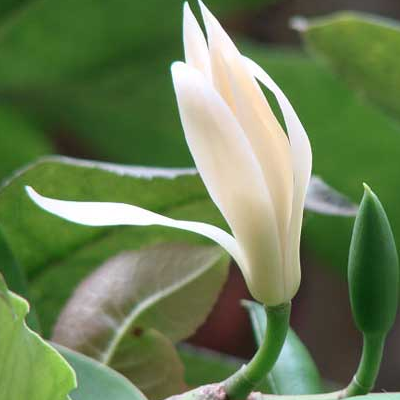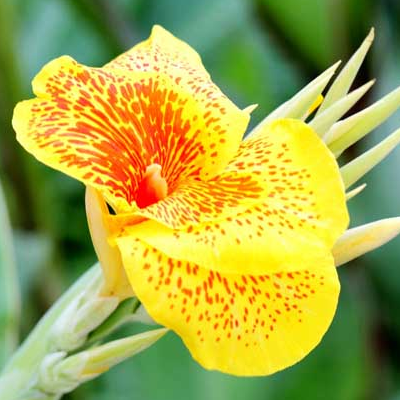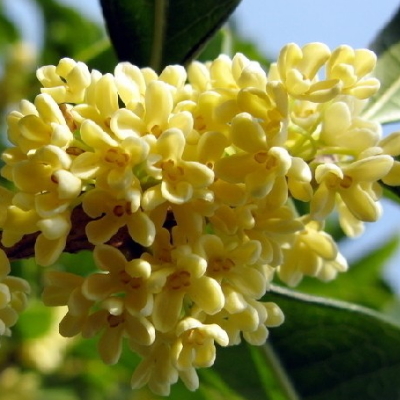What is the difference between the propagation methods of white orchids and magnolia?
The florescence of the white orchid is very long, and the fragrance of the flower is also very strong, so what are the breeding methods of the white orchid? What's the difference between white orchids and magnolia?

What are the breeding methods of white orchids:
1. Sowing and reproduction
Sowing seedlings at the end of September or early October, harvest the mature fruit, take out the seeds, soak them in ash water for 2 days, then scrub the waxy aril, rinse them with clean water, and then sow the seeds. The seeds can also be washed and refrigerated with wet sand stratification method, otherwise they are easy to lose their germination ability, and they will be sown indoors in March of the following year and can emerge in about 20 days.
2. Cuttage propagation
White orchid can be propagated by cutting, but the ability of reproduction and regeneration of white orchid is poor, so it is not easy to root and survive by cutting, so it is not adopted.
3. Grafting propagation
White orchids are often propagated by grafting, generally using the 2-3-year-old Zhuo of Magnolia and Huanglan as rootstocks, and there are two kinds of grafting methods, one is by grafting, the other is by cutting.
1, lean on to connect: rely on the time, from spring to autumn, the whole growing season can be carried out. Most of them are carried out from April to July. The best place to lean on is 70 cm from the ground. After being tied up, it is wrapped in a mass of mud and wrapped in leaves to prevent Rain Water from scouring. It can be cut off after about 60 days. Grafting is an easier way to survive, but it is not as exuberant as cutting.
2. Cutting: in the middle and late September, the well-developed branches of Magnolia should be selected as the scion, the section of the rootstock and the scion should be closely combined, bound and mudded with plastic film strips, and the scion should be buried with soil to keep the soil moist. In northern China, the scion should be covered with straw in winter, and the mulch should be removed in the next spring. 4-5 buds in the upper part of the branch should be retained after germination, and the rest of the buds should be removed. After 2-3 years of routine maintenance, they can bloom.
4. Striping propagation
White orchid striping propagation is also used in more ways of reproduction, mainly divided into ordinary striping and high branch crimping.
1. Ordinary pressing: the ordinary pressing is best carried out in February to March, cut the base of the branch to be pressed into half the depth, then cut a section upward, and then stick a tile in the middle, then gently press it into the soil without breaking it, insert it into the soil with "U"-shaped thick wire, fix it, prevent it from warping, and then pile it on the soil. After the root bud is sent out, the strip can be cut off and planted in spring.
2. High branch pressing: select strong and disease-free twigs (1.5-2 cm in diameter) on the mother plant before entering, cut the cracks in the lower part of the basin fork, then cover them with bamboo tube or bottomless tile pot, fill them with culture soil, tie them tightly with string on the outside, be careful not to touch them, often spray a small amount of water, keep them moist, and grow new roots around May of the following year.
What's the difference between white orchids and magnolia:
Different families and genera
1. Magnolia: plant kingdom, angiosperm phylum, dicotyledonous class, Magnolia, Magnoliaceae, Magnolia, Magnolia subgenus.
2. White orchid: plant kingdom, angiosperm phylum, dicotyledonous class, primitive perianth subclass, Ranuncula, Magnoliaceae, Magnolia, Michelia plants.
Florescence difference
1. Magnolia Magnolia: Magnolia blossoms in March, blossoms once a year, blossoms first and then leaves, blue and white.
2. White orchids: White orchids can generally bloom twice, the first in summer and the second in autumn, with more flowers in summer and milky white in general.
Different habits
1. Magnolia Magnolia: Magnolia is suitable for growing in warm and humid climate and fertile and loose soil, likes light, is not resistant to drought and waterlogging, dies after 2-3 days of flooding, is sensitive to toxic gases such as sulfur dioxide and chlorine, and has poor resistance.
2. White orchid: White orchid is light-loving, afraid of high temperature, not cold-resistant, suitable for slightly acidic soil, warm and humid, not resistant to drought and waterlogging, sensitive to toxic gases such as sulfur dioxide and chlorine, and poor resistance.
Feature difference
1. Magnolia Magnolia: Magnolia Magnolia has first leaves open, terminal, large flowers, 12-15 cm in diameter, 9 perianth, bell-shaped, actinomorphic, rose Corolla, free stamens, centrifugal pistil, superior ovary.
2. White orchid: White orchid, extremely fragrant, perianth segments 10, lanceolate, 3-4 cm long, 3-5 mm wide, staminal connective protruding long tip, gynoecium puberulent, pistil stalk ca. 4 mm long, carpels numerous, usually partially rudimentary, with the extension of receptacle at maturity to form a sparse aggregate fruit, which is bright red when ripe.
The efficacy is different
1. Magnolia Magnolia: Magnolia flavour, warm in nature, with the effect of dispelling wind, dispelling cold and dredging orifice, purging lung and nose, can be used for headache, blood stasis dysmenorrhea, nasal congestion, acute and chronic sinusitis, allergic rhinitis and so on.
2. White orchid: the white orchid tastes bitter, pungent, mild in nature, and has the effect of warming the lungs and relieving cough and resolving turbidity. it is mainly for the treatment of chronic bronchitis, prostatitis, white turbidity, women's leucorrhea and so on.
All right, guys, you all understand.
What's the difference between Magnolia and Magnolia?
Recently, a friend asked Magnolia and Magnolia what's the difference? what's the difference? So the editor specifically inquired about some information about Magnolia and Magnolia and found that they are still quite different. Let's take a look at the difference between Magnolia and Magnolia.
Magnolia
Magnolia Magnolia is a variety of magnolia with white flowers. Also known as Mulan, Magnolia and so on. Deciduous trees of Magnoliaceae, generally 2m high or up to 15m high. The flowers are white, large and fragrant, the first leaves open and the florescence is about 10 days. Magnolia is a famous flower and tree in China. It is the most important ornamental tree in early spring in northern China. It is also named as city flower by Shanghai. It has been cultivated for about 2500 years and is the most valuable ornamental tree in the courtyard. Magnolia is native to the provinces of central China and is now cultivated in Beijing and south of the Yellow River basin. Now it is more common in gardens, factories and mines to plant alone, scattered planting, or on both sides of the road as street trees.
White orchid
Magnolia is an evergreen tree of the genus Magnoliaceae, up to 17 to 20 meters high, potted plants are usually 3 to 4 meters tall, and there are also small plants. Bark gray, young branches evergreen, leaves oblong, simple leaves alternate, turquoise, leathery glossy, long oval. The bud of the white orchid is like the pen of a brush. It has 8 petals, white as snow, born in the axils of leaves. The flower color of white orchid is only white and yellowish in white. its petals are fleshy, long lanceolate and fragrant, with florescence from April to May and August to September. In addition, white orchid contains linalool, phenylethanol, methyl eugenol and other ingredients, which can be used as smoked tea, wine or essence after collection. Now many perfumes, moisturizers and snowflake creams that show the scent of brandy are often used as ingredients.
The above is the details of Magnolia and Magnolia, from which we can see that Magnolia is snow-white, with not many leaves, while Magnolia belongs to the small plant floral family, the flower shape is relatively small, but very fragrant. Both Magnolia and Magnolia are good varieties of flowers, and friends who need to plant can inquire for details.
Extended reading:
How to prune white orchids, how to raise them, how to grow them, how to cultivate them and what to pay attention to.
How do white orchids reproduce? Introduction to the propagation methods of white orchids
White orchid is a famous ornamental flowers and trees, with white and elegant colors, charming fragrance, long flowering period, dense green branches and leaves, very high ornamental and beautifying value, simple maintenance, and more ways of reproduction. Grafting and striping are used more, while sowing and cutting are used less, but family breeding, grafting and crimping are enough.
Magnolia magnolia sowing and propagation
Sowing seedlings at the end of September or early October, harvest the mature fruit, take out the seeds, soak them in ash water for 2 days, then scrub the waxy aril, rinse them with clean water, and then sow the seeds. The seeds can also be washed and refrigerated with wet sand stratification method, otherwise they are easy to lose their germination ability, and they will be sown indoors in March of the following year and can emerge in about 20 days.
Cuttage propagation of white orchid
White orchid can be propagated by cutting, but the ability of reproduction and regeneration of white orchid is poor, so it is not easy to root and survive by cutting, so it is not adopted.
Grafting propagation of white orchid
White orchids are often propagated by grafting, generally using the 2-3-year-old Zhuo of Magnolia and Huanglan as rootstocks, and there are two kinds of grafting methods, one is by grafting, the other is by cutting.
1, lean on to connect: rely on the time, from spring to autumn, the whole growing season can be carried out. Most of them are carried out from April to July. The best place to lean on is 70 cm from the ground. After being tied up, it is wrapped in a mass of mud and wrapped in leaves to prevent Rain Water from scouring. It can be cut off after about 60 days. Grafting is an easier way to survive, but it is not as exuberant as cutting.
2. Cutting: in the middle and late September, the well-developed branches of Magnolia should be selected as the scion, the section of the rootstock and the scion should be closely combined, bound and mudded with plastic film strips, and the scion should be buried with soil to keep the soil moist. In northern China, the scion should be covered with straw in winter, and the mulch should be removed in the next spring. 4-5 buds in the upper part of the branch should be retained after germination, and the rest of the buds should be removed. After 2-3 years of routine maintenance, they can bloom.
Striping propagation of white orchid
White orchid striping propagation is also used in more ways of reproduction, mainly divided into ordinary striping and high branch crimping.
1. Ordinary pressing: the ordinary pressing is best carried out in February to March, cut the base of the branch to be pressed into half the depth, then cut a section upward, and then stick a tile in the middle, then gently press it into the soil without breaking it, insert it into the soil with "U"-shaped thick wire, fix it, prevent it from warping, and then pile it on the soil. After the root bud is sent out, the strip can be cut off and planted in spring.
2. High branch pressing: select strong and disease-free twigs (1.5-2 cm in diameter) on the mother plant before entering, cut the cracks in the lower part of the basin fork, then cover them with bamboo tube or bottomless tile pot, fill them with culture soil, tie them tightly with string on the outside, be careful not to touch them, often spray a small amount of water, keep them moist, and grow new roots around May of the following year.
- Prev

Can canna eat? what are the breeding methods?
Canna is a plant with great greening value and is very suitable for breeding, so can canna be eaten? What are the breeding methods of canna? Can canna be eaten: some varieties can be eaten. Some are not allowed. Canna is a perennial perennial herb, native to America, with more than 50 varieties in the world.
- Next

Can sweet-scented osmanthus trees be planted indoors? what plants can be planted?
Indoor is a rest environment, so it is necessary to ensure that this environment is clean and hygienic, so can sweet-scented osmanthus trees be planted indoors? What plants can be grown indoors? Can you plant sweet-scented osmanthus trees indoors? you can plant sweet-scented osmanthus trees indoors, but there is also a note that the fragrance of sweet-scented osmanthus is very strong.
Related
- Fuxing push coffee new agricultural production and marketing class: lack of small-scale processing plants
- Jujube rice field leisure farm deep ploughing Yilan for five years to create a space for organic food and play
- Nongyu Farm-A trial of organic papaya for brave women with advanced technology
- Four points for attention in the prevention and control of diseases and insect pests of edible fungi
- How to add nutrient solution to Edible Fungi
- Is there any good way to control edible fungus mites?
- Open Inoculation Technology of Edible Fungi
- Is there any clever way to use fertilizer for edible fungus in winter?
- What agents are used to kill the pathogens of edible fungi in the mushroom shed?
- Rapid drying of Edible Fungi

